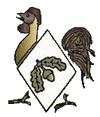40th Division (United Kingdom)
| 40th Division | |
|---|---|
 Insignia showing a bantam. | |
| Active |
1915–1918 1943–1944 1949–? |
| Country |
|
| Branch |
|
| Type | Infantry |
| Size | Division |
| Commanders | |
| Notable commanders | Major-General H.G. Ruggles-Brise |
The 40th Division was an infantry division of the British Army active during World War I, where it served on the Western Front. It was a division of Lord Kitchener's New Army volunteers, mostly "bantam" recruits of below regulation height. It was later briefly reformed as a fictional deception formation in World War II, and during the early years of the Cold War was recreated a third time to garrison Hong Kong.
History
First World War
The 40th Division was originally formed as a Kitchener's Army 'Bantam' division between September and December 1915 for service in the First World War. 'Bantam' personnel were those who were under the Army regulation height but otherwise fit for service. It comprised the 119th, 120th, and 121st Brigades. The 40th Division moved to the Western Front in June 1916 and served there throughout the First World War.
The most notable action of the division may be its participation in the Battle of Cambrai in late 1917. By 22 November the British were left exposed in a salient on the battlefield. Field Marshal Sir Douglas Haig, Commander-in-Chief (C-in-C) of the British Expeditionary Force (BEF) on the Western Front, wanted Bourlon Ridge and the exhausted 62nd (2nd West Riding) Division was replaced by the 40th Division, commanded by Major-General John Ponsonby, on 23 November. Supported by almost a hundred tanks and 430 guns, the 40th attacked into the woods of Bourlon Ridge on the morning of the 23rd. They made little progress. The Germans had put two divisions of Gruppe Arras on the ridge with another two in reserve and Gruppe Caudry was reinforced. The 40th Division reached the crest of the ridge but were held there and suffered over 4,000 casualties for their efforts in three days. The division was subsequently driven back in the German counterattacks, suffering many more losses.
From July 1918 until March 1919, the division was led by General Sir William Peyton and took part in the Hundred Days advance through Flanders.[1]
Second World War
The Division was re-formed by the British Army in 1943 during the Second World War for deception purposes. It was formed in Sicily from the H.Q. of the 43rd Infantry Brigade and its units were designated for deception purposes as well. The division ceased to exist on 17 June 1944.
Post war
Following the increasing success of the Communists in the Chinese Civil War, the 40th Division was reformed to bolster the defences of Hong Kong in 1949 under the command of Major General G.C. Evans. In Hong Kong the Division comprised the 26th Gurkha, 27th and 28th Infantry Brigades, and 3rd Royal Tank Regiment. However the 27th Brigade was soon dispatched to Korea in August 1950, and followed by other units of the division. The Division was later disbanded.
General Officer Commanding
- Major-General H.G. Ruggles-Brise 1916 - 1917
- Major-General John Ponsonby 1917 - 1918
- Major-General Sir William Peyton 1918 - March 1919
- Major General G.C. Evans 1949 - 1950
See also
References
- ↑ William Eliot Peyton at the web site of the CENTRE FOR FIRST WORLD WAR STUDIES online at bham.ac.uk (accessed 19 January 2008)
Bibliography
- Gregory Blaxland. (1971). The Regiments Depart: A History of the British Army 1945–70. William Kimber: London.
- Whitton, F. E. (1926). History of the 40th Division (N & M Press, 2004 ed.). Aldershot: Gale and Polden. ISBN 978-1-84342-870-1. Retrieved 13 October 2014.
External links
- Unit Histories Site, 40th Infantry Division
- The Long, Long, Trail: The British Army in the First World War